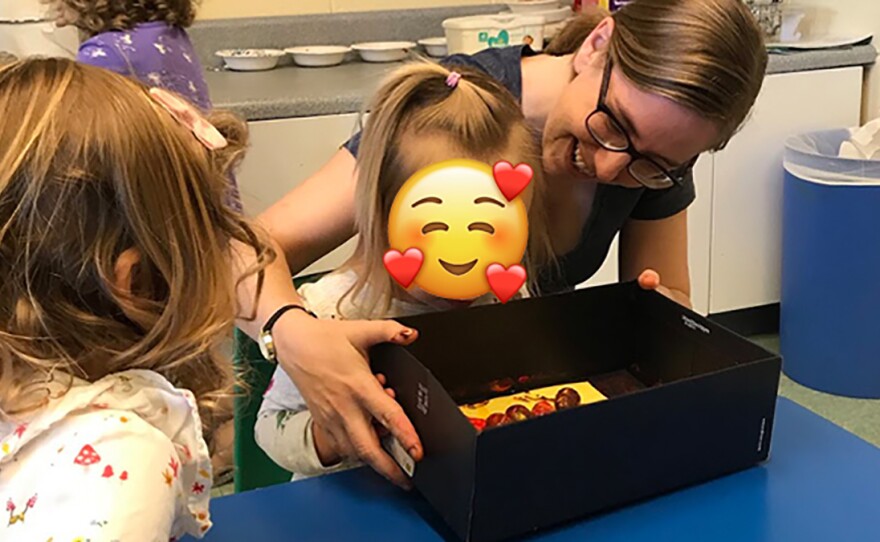The following is a VPM Blog post by Emily Hicks, a preschool teacher in Henrico, Virginia.
It's fairly easy to make your own sensory box at home. All you need is a plastic bin - like a storage bin! The bin we use at school is about 1 1⁄2 ft by 2 ft, but yours doesn't need to be that big - whatever you have will work. You can fill a sensory box with all sorts of things you may already have around the house.
NoteSensory boxes need to be a supervised activity. Many of the things you’ll fill a sensory box with are small enough to be choking hazards.
Water Sensory Box
Simple water play is great for pouring practice and developing those fine motor skills. Add water to your sensory box and include cups, basters, water cans or toys.pan>
Washing Dishes
Give your child a tub of water with a little dish soap and some sponges and let them wash their toy dishes. Once they hone their skills a bit, you can have them start washing their own dishes after meals.
Dirt Sensory Box
Build a dirt base in your sensory box. Then add plastic shovels, pots, or even toy trucks. Kids will jump on any excuse to play in the dirt!
Rice and Pasta Sensory Box
You can put dried pasta or rice in your sensory box and add a little color with vinegar and food coloring. You can also use rubbing alcohol, but it may be a bit harder to come by these days if you don’t already have it on hand.
Pasta Sensory Box Materials:
- 3 cups pasta
- Any small pasta, like macaroni or penne, will do
- 1⁄4 cup white vinegar
- Food coloring
Pasta Sensory Box Directions:
- Fill a ziplock bag with pasta
- Add vinegar and food coloring – liquid or gel food coloring will work
- Close bag and mix until all pasta is coated.
- Let it sit in the bag for 10 minutes
- Remove pasta from the bag and spread it on a baking sheet
- Let pasta air-dry overnight
Rice Sensory Box Materials:
- 1 cup of rice
- 1⁄2 tsp white vinegar
- Food coloring
- Rice Sensory Box Directions
- Fill ziplock bag or Tupperware container with rice
- Mix in food coloring
- Drizzle vinegar over the top
- Close bag or container and shake until rice is thoroughly mixed
- Remove rice from the bag and spread on a baking sheet
- Let rice air dry (at least) overnight.
Bonus! You can also fill a bin with cooked spaghetti and use it for scissor practice.
Shaving Cream Sensory Box
I could probably find a way to use shaving cream in every activity! Shaving cream is such a fun sensory experience for kids, it’s very easy to clean up and smells wonderful. You can just spray shaving cream in a container and let them explore, or you can add materials to it. If you have them in your home, one of my favorite things to add is foam blocks. The shaving cream makes them stick together, so it makes for some fun building.
Natural Sensory Box
You can build a sensory box using materials found in your own backyard! Have your child go exploring with you and pick out sticks, leaves, pine cones—whatever your environment has to offer. Bring them back inside and explore them in the box. Ask your children: Can you build with them? Can you scoop and fill with rocks and acorns?
Sand Sensory Box
You can use things like water beads, sand, kinetic sand if you have them available at home, and let your child explore with paintbrushes to uncover hidden objects.
Around The House Sensory Box
Fun materials for a sensory box can be found all around your home. Consider using shredded paper or strips of wrapping paper, Easter grass, ribbons, popping corn, dried beans, or whatever your child feels drawn to so long as it doesn’t aggravate allergies.
Sensory Box Tools
Never underestimate a toddler's desire to simply put things in other things. You can include basically anything they can use to scoop, pour, or fill. Here are some of my favorites:
- Measuring cups
- Spoons
- Scoops
- Shovels
- Basters
- Colanders
- Sand and water toys
- Paper towel tubes
- Ice trays
- Easter eggs
- Tupperware
Sensory Bottles
One of the easiest ways to make a sensory bottle is to fill a bottle a little more than halfway with water and add a little food coloring. Then add oil. Baby oil is great, but vegetable oil works too. Be careful not to fill it all the way to the top. Then add small plastic toys and a cap. I always seal the cap with hot glue to make sure little hands won't remove it. Now you've got a great wavy sensory bottle to play with.



